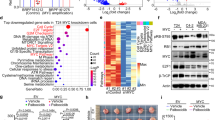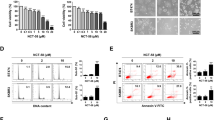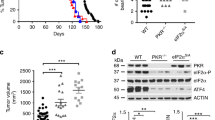Abstract
Ansamycin antibiotics, such as 17-allylaminogeldanamycin (17-AAG), bind to Hsp90 and regulate its function, resulting in the proteasomal degradation of a subset of signaling proteins that require Hsp90 for conformational maturation. HER2 is a very sensitive target of these drugs. Ansamycins cause RB-dependent G1 arrest that is associated with loss of D-cyclins via a PI3 kinase, Akt dependent pathway. Downregulation of D-cyclin was due, in part, to loss of Akt expression in response to drug. Moreover, in HER2 overexpressing breast cancer cells, 17-AAG caused rapid inhibition of Akt activity prior to any change in Akt protein. Ansamycins caused rapid degradation of HER2 and a concomitant loss in HER3 associated PI3 kinase activity. This led to a loss of Akt activity, dephosphorylation of Akt substrates, and loss of D-cyclin expression. Introduction into cells of a constitutively membrane bound form of PI3 kinase prevented the effects of the drug on Akt activity and D-cyclins. Thus, in breast cancer cells with high HER2, Akt activation by HER2/HER3 heterodimers is required for D-cyclin expression. In murine xenograft models, non-toxic doses of 17-AAG markedly reduced the expression of HER2 and phosphorylation of Akt and inhibited tumor growth. Thus, pharmacological inhibition of Akt activation is achievable with ansamycins and may be useful for the treatment of HER2 driven tumors.
This is a preview of subscription content, access via your institution
Access options
Subscribe to this journal
Receive 50 print issues and online access
$259.00 per year
only $5.18 per issue
Buy this article
- Purchase on Springer Link
- Instant access to full article PDF
Prices may be subject to local taxes which are calculated during checkout





Similar content being viewed by others
References
Alessi DR, James SR, Downes CP, Holmes AB, Gaffney PR, Reese CB, Cohen P . 1997 Curr. Biol. 7: 261–269
Bardelli A, Basile ML, Audero E, Giordano S, Wennstrom S, Menard S, Comoglio PM, Ponzetto C . 1999 Oncogene 18: 1139–1146
Baselga J, Tripathy D, Mendelsohn J, Baughman S, Benz CC, Dantis L, Sklarin NT, Seidman AD, Hudis CA, Moore J, Rosen PP, Twaddell T, Henderson IC, Norton L . 1996 J Clin Oncol 14: 737–744
Casamayor A, Morrice NA, Alessi DR . 1999 Biochem J 342: 287–292
Czar MJ, Galigniana MD, Silverstein AM, Pratt WB . 1997 Biochemistry 36: 7776–7785
Diehl JA, Cheng M, Roussel MF, Sherr CJ . 1998 Genes Dev. 12: 3499–3511
Fenteany G, Standaert RF, Lane WS, Choi S, Corey EJ, Schreiber SL . 1995 Science 268: 726–731
Franke TF, Yang SI, Chan TO, Datta K, Kazlauskas A, Morrison DK, Kaplan DR, Tsichlis PN . 1995 Cell 81: 727–736
Gilewski T, Seidman A, Norton L, Hudis C . 2000 Cancer Chemother Pharmacol 46: S23–S26
Hellyer NJ, Cheng K, Koland JG . 1998 Biochem J 333: 757–763
Li J, Yen C, Liaw D, Podsypanina K, Bose S, Wang SI, Puc J, Miliaresis C, Rodgers L, McCombie R, Bigner SH, Giovanella BC, Ittmann M, Tycko B, Hibshoosh H, Wigler MH, Parsons R . 1997 Science 275: 1943–1947
Marte BM, Downward J . 1997 Trends Biochem Sci 22: 355–358
Mimnaugh EG, Chavany C, Neckers L . 1996 J Biol Chem 271: 22796–22801
Muise-Helmericks RC, Grimes HL, Bellacosa A, Malstrom SE, Tsichlis PN, Rosen N . 1998 J Biol Chem 273: 29864–29872
Munster PN, Basso A, Solit D, Norton L, Rosen N . 2001 Clin Cancer Res 7: 2228–2236
Page C, Lin HJ, Jin Y, Castle VP, Nunez G, Huang M, Lin J . 2000 Anticancer Res 20: 407–416
Pegram M, Hsu S, Lewis G, Pietras R, Beryt M, Sliwkowski M, Coombs D, Baly D, Kabbinavar F, Slamon D . 1999 Oncogene 18: 2241–2251
Pegram MD, Lipton A, Hayes DF, Weber BL, Baselga JM, Tripathy D, Baly D, Baughman SA, Twaddell T, Glaspy JA, Slamon DJ . 1998 J Clin Oncol 16: 2659–2671
Penuel E, Martin GS . 1999 Mol Biol Cell 10: 1693–1703
Pratt WB . 1998 Proc Soc Exp Biol Med 217: 420–434
Prodromou C, Roe SM, O'Brien R, Ladbury JE, Piper PW, Pearl LH . 1997 Cell 90: 65–75
Sato S, Fujita N, Tsuruo T . 2000 Proc Natl Acad Sci USA 97: 10832–10837
Schneider C, Sepp-Lorenzino L, Nimmesgern E, Ouerfelli O, Danishefsky S, Rosen N, Hartl FU . 1996 Proc Natl Acad Sci USA 93: 14536–14541
Schulte TW, Blagosklonny MV, Romanova L, Mushinski JF, Monia BP, Johnston JF, Nguyen P, Trepel J, Neckers LM . 1996 Mol Cell Biol 16: 5839–5845
Skorski T, Bellacosa A, Nieborowska-Skorska M, Majewski M, Martinez R, Choi JK, Trotta R, Wlodarski P, Perrotti D, Chan TO, Wasik MA, Tsichlis PN, Calabretta B . 1997 EMBO J 16: 6151–6161
Slamon DJ, Clark GM, Wong SG, Levin WJ, Ullrich A, McGuire WL . 1987 Science 235: 177–182
Slamon DJ, Godolphin W, Jones LA, Holt JA, Wong SG, Keith DE, Levin WJ, Stuart SG, Udove J, Ullrich A, Press MF . 1989 Science 244: 707–712
Srethapakdi M, Liu F, Tavorath R, Rosen N . 2000 Cancer Res 60: 3940–3946
Stambolic V, Suzuki A, de la Pompa JL, Brothers GM, Mirtsos C, Sasaki T, Ruland J, Penninger JM, Siderovski DP, Mak TW . 1998 Cell 95: 29–39
Stancato LF, Silverstein AM, Owens-Grillo JK, Chow YH, Jove R, Pratt WB . 1997 J Biol Chem 272: 4013–4020
Steck PA, Pershouse MA, Jasser SA, Yung WK, Lin H, Ligon AH, Langford LA, Baumgard ML, Hattier T, Davis T, Frye C, Hu R, Swedlund B, Teng DH, Tavtigian SV . 1997 Nat Genet 15: 356–362
Stepanova L, Leng X, Parker SB, Harper JW . 1996 Genes Dev. 10: 1491–1502
Tal M, Wetzler M, Josefberg Z, Deutch A, Gutman M, Assaf D, Kris R, Shiloh Y, Givol D, Schlessinger J . 1988 Cancer Res 48: 1517–1520
Vanhaesebroeck B, Alessi DR . 2000 Biochem J 346: Pt 3 561–576
Wallasch C, Weiss FU, Niederfellner G, Jallal B, Issing W, Ullrich A . 1995 EMBO J 14: 4267–4275
Webb CP, Hose CD, Koochekpour S, Jeffers M, Oskarsson M, Sausville E, Monks A, Vande Woude GF . 2000 Cancer Res 60: 342–349
Wennstrom S, Downward J . 1999 Mol Cell Biol 19: 4279–4288
Whitesell L, Cook P . 1996 Mol Endocrinol 10: 705–712
Xu W, Mimnaugh E, Rosser MF, Nicchitta C, Marcu M, Yarden Y, Neckers L . 2001 J. Biol. Chem. 276: 3702–3708
Acknowledgements
We thank J Downward and S Wennstrom for providing the p110-CAAX construct. We thank M Moasser for his helpful discussions and technical assistance. This work was in part supported by the NCI Breast SPORE program grant P50CA68425, grant number CA0951 from the National Cancer Institute and the generous support of the Arlene Taub Foundation.
Author information
Authors and Affiliations
Corresponding author
Rights and permissions
About this article
Cite this article
Basso, A., Solit, D., Munster, P. et al. Ansamycin antibiotics inhibit Akt activation and cyclin D expression in breast cancer cells that overexpress HER2. Oncogene 21, 1159–1166 (2002). https://doi.org/10.1038/sj.onc.1205184
Received:
Revised:
Accepted:
Published:
Issue Date:
DOI: https://doi.org/10.1038/sj.onc.1205184
Keywords
This article is cited by
-
Gene expression trend changes in breast cancer populations over two decades: insights from The Cancer Genome Atlas database
Hereditas (2022)
-
The HSP-RTK-Akt axis mediates acquired resistance to Ganetespib in HER2-positive breast cancer
Cell Death & Disease (2021)
-
A phase I trial of ganetespib in combination with paclitaxel and trastuzumab in patients with human epidermal growth factor receptor-2 (HER2)-positive metastatic breast cancer
Breast Cancer Research (2017)
-
Nanocarrier based on the assembly of protein and antisense oligonucleotide to combat multidrug resistance in tumor cells
Science China Chemistry (2017)
-
WASF3 provides the conduit to facilitate invasion and metastasis in breast cancer cells through HER2/HER3 signaling
Oncogene (2016)



